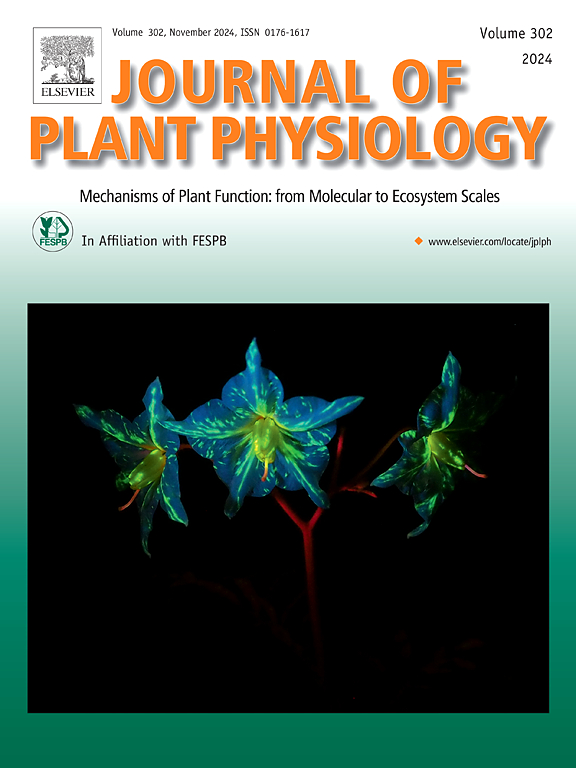ARR1/12-ETP1/2 model negatively regulates submergence-induced hypoxia response in A. thaliana
IF 4.1
3区 生物学
Q1 PLANT SCIENCES
引用次数: 0
Abstract
Submergence-induced hypoxia stress hampers plant growth and yield, yet its molecular mechanisms remain elusive. Here, we found that ETP1/2 are repressed by submergence stress and negatively regulate plant tolerance to submergence. Further analysis showed that the repression of ETP1/2 during the submergence response is at least partly caused by the decreased expression of ARR1/12, as ARR1/12 can directly bind to the promoters via the AGATTTG motifs to activate ETP1/2 expression. ChIP-qPCR, Y1H, and EMSA further confirmed the direct interaction between ARR12 and ETP1/2. Genetic analysis demonstrated that ETP1/2 negatively regulates the submergence response downstream of ARR1/12. Additionally, some SNPs in the ARR1/12 and ETP1/2 promoters are correlated with habitat precipitation, suggesting a possible evolutionary adaptation through these SNPs. Our findings thus establish an ARR1/12-ETP1/2 module for precisely modulating the plant's hypoxic response, offering potential strategies to enhance crop resistance to submergence.
ARR1/12-ETP1/2模型负向调控拟南芥淹没缺氧反应
水下缺氧胁迫对植物生长和产量的影响,其分子机制尚不明确。本研究发现,ETP1/2基因受到淹没胁迫的抑制,负向调控植物对淹没的耐性。进一步分析表明,浸没应答中ETP1/2的抑制至少部分是由于ARR1/12的表达降低,因为ARR1/12可以通过AGATTTG基序直接结合启动子激活ETP1/2的表达。ChIP-qPCR、Y1H和EMSA进一步证实了ARR12与ETP1/2之间的直接相互作用。遗传分析表明,ETP1/2负调控ARR1/12下游的淹没响应。此外,ARR1/12和ETP1/2启动子中的一些snp与栖息地降水相关,表明可能通过这些snp进行进化适应。因此,我们的研究结果建立了精确调节植物缺氧反应的ARR1/12-ETP1/2模块,为提高作物抗淹性提供了潜在的策略。
本文章由计算机程序翻译,如有差异,请以英文原文为准。
求助全文
约1分钟内获得全文
求助全文
来源期刊

Journal of plant physiology
生物-植物科学
CiteScore
7.20
自引率
4.70%
发文量
196
审稿时长
32 days
期刊介绍:
The Journal of Plant Physiology is a broad-spectrum journal that welcomes high-quality submissions in all major areas of plant physiology, including plant biochemistry, functional biotechnology, computational and synthetic plant biology, growth and development, photosynthesis and respiration, transport and translocation, plant-microbe interactions, biotic and abiotic stress. Studies are welcome at all levels of integration ranging from molecules and cells to organisms and their environments and are expected to use state-of-the-art methodologies. Pure gene expression studies are not within the focus of our journal. To be considered for publication, papers must significantly contribute to the mechanistic understanding of physiological processes, and not be merely descriptive, or confirmatory of previous results. We encourage the submission of papers that explore the physiology of non-model as well as accepted model species and those that bridge basic and applied research. For instance, studies on agricultural plants that show new physiological mechanisms to improve agricultural efficiency are welcome. Studies performed under uncontrolled situations (e.g. field conditions) not providing mechanistic insight will not be considered for publication.
The Journal of Plant Physiology publishes several types of articles: Original Research Articles, Reviews, Perspectives Articles, and Short Communications. Reviews and Perspectives will be solicited by the Editors; unsolicited reviews are also welcome but only from authors with a strong track record in the field of the review. Original research papers comprise the majority of published contributions.
 求助内容:
求助内容: 应助结果提醒方式:
应助结果提醒方式:


